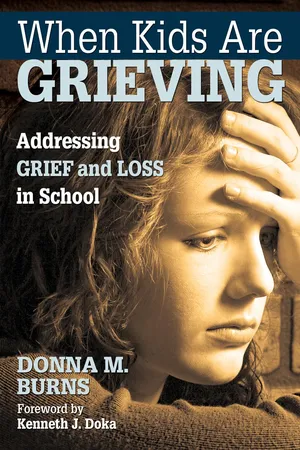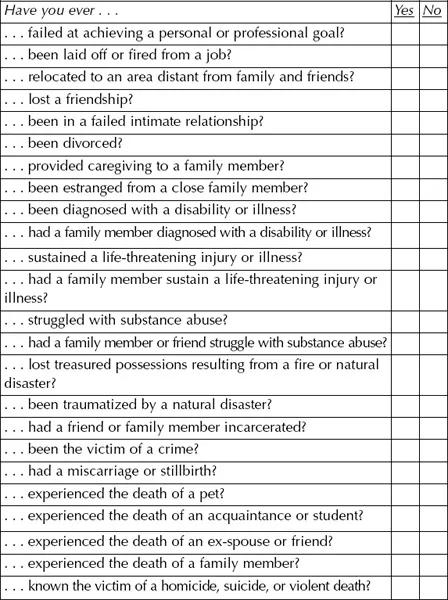
This is a test
- 128 pages
- English
- ePUB (mobile friendly)
- Available on iOS & Android
eBook - ePub
Book details
Book preview
Table of contents
Citations
About This Book
This primer helps educators understand and respond appropriately to students' unique expressions of grief, facilitate effective interventions, and determine when to refer a child to a specialist.
Frequently asked questions
At the moment all of our mobile-responsive ePub books are available to download via the app. Most of our PDFs are also available to download and we're working on making the final remaining ones downloadable now. Learn more here.
Both plans give you full access to the library and all of Perlego’s features. The only differences are the price and subscription period: With the annual plan you’ll save around 30% compared to 12 months on the monthly plan.
We are an online textbook subscription service, where you can get access to an entire online library for less than the price of a single book per month. With over 1 million books across 1000+ topics, we’ve got you covered! Learn more here.
Look out for the read-aloud symbol on your next book to see if you can listen to it. The read-aloud tool reads text aloud for you, highlighting the text as it is being read. You can pause it, speed it up and slow it down. Learn more here.
Yes, you can access When Kids Are Grieving by Donna M. Burns in PDF and/or ePUB format, as well as other popular books in Education & Education Counseling. We have over one million books available in our catalogue for you to explore.
Information
1
Am I Qualified to Work With Grieving Children?
He who knows others is wise.
He who knows himself is enlightened.
He who knows himself is enlightened.
—Tao Te Ching
Overview
Most school-aged children have experienced, or will experience, some form of loss in their lives. Some of these experiences are not always recognized as grievable losses by educators (e.g., illness, moving, divorce), yet these types of events can profoundly affect academic performance, emotional stability, and social interactions. Death-related losses, including suicide, violence, or other traumatic events, often find the school professional ill-equipped and grappling with ways to comfort and deal with distraught students. It is essential that educators not only be skilled at identifying students affected by loss but possess the competencies to comfortably address these inevitable situations. Toward that end, an exploration of one’s awareness of and attitudes toward issues of grief and loss is necessary.
Self-Awareness
Am I Qualified to Work With Grieving Children?
A concern often encountered in working with educators, including school and counseling psychologists, is whether they have the skills necessary to work with children who are grieving. Certainly there are specialists uniquely qualified in the field of bereavement counseling and facilitation, but what a grieving student needs more than anything is to be listened to and soothed by a caring and empathetic individual. Who better to provide such support and comfort than someone with whom the student interacts on a regular basis? It is your genuine desire to help, partnered with your own experiences, that truly qualifies you to work with grieving children.
There may be times, however, when it is necessary to enlist the help of professionals. According to Grollman (2000), grieving children and adolescents who experience physical, emotional, or psychological distress for a prolonged period of time should be referred to a qualified specialist. Information about specialized training in bereavement counseling or facilitation can be found in the professional development section in Chapter 7.
Before continuing on to the exercise that follows, it’s important to become familiar with some of the terminology most often associated with loss. The term itself, loss, can be thought of as the end of a relationship with someone or something to whom or to which we’ve become attached. Terms used to refer to those coping with loss include bereavement, grief, and mourning. Although these terms are often used interchangeably and are clearly related, there are subtle differences among them. While definitions may vary from one source to another, the terms will be defined as follows in this text. Bereavement most typically refers to the state of having suffered a loss or to have been deprived of something. Grief, a term that will be used frequently throughout the text, refers to the response to loss. These responses manifest themselves in a variety of ways such as physically, behaviorally, emotionally, socially, and spiritually. Finally, mourning can be referred to as the process of coping with loss and encompasses both private and public expressions of grief.
To develop a sense of awareness and gauge your level of competency, please complete the Grief and Loss Self-Assessment Checklist (see Activity 1.1). You may wish to reproduce this assessment tool to take now and reflect on at a later time. This is a personal, self-directed checklist that does not require professional interpretation. Once completed, you will be able to determine for yourself the degree of experience you have with issues of loss.
Activity 1.1 Grief and Loss Self-Assessment Checklist
Please check either yes or no for each of the following.

As you review your responses, you may realize that you know more about grief and loss than you thought. Recognize the relationship between your experiences and those of grieving students.
Factors Affecting Attitudes and Beliefs Toward Loss
As you can see by the graphic representation, multiple factors affect each individual’s attitudes and beliefs toward loss (see Figure 1.1). Take a closer look at how each dimension contributes in part to your perceptions.
Figure 1.1 Factors Affecting Attitudes and Beliefs Toward Loss

How you as the dynamic core respond to loss is, in addition to outside forces, influenced by such intrinsic variables as emotionality, temperament, and other nontangible characteristics and traits that define one’s personality. The interaction between you and each external event shapes your attitudes and beliefs. These external forces include, but are not limited to, the following:
- Life experiences, as only you have lived them: Each disappointment, setback, and loss—and the ways in which you navigated them—culminate in what I call a personal loss script. This script represents the grievable experiences unique to you and underscores your attitudes and beliefs toward loss.
- Culture, as reflective of the customs, traditions, and values specific to your heritage and lifestyle: Responses to loss are often mediated by the norms of the familial and community systems integral to your life.
- Beliefs, as a fundamental part of your affiliations and practices: Your perspectives and responses to loss are affected by your religious or nonreligious beliefs.
- Social forces, as a function of ever-present influences: Whether it be in your home, neighborhood, workplace, or other setting, a dynamic interplay occurs in which exchanges of ideas, opinions, and viewpoints exist regarding issues of loss.
- Media influences, as source of information: The accessibility of media sources immediately connects the world to the individual. How information is generated and presented can shape public perceptions, attitudes, and opinions about issues surrounding loss and death.
Anxiety and Fears
Information about loss-related anxiety and fears can be found in death and dying literature. According to Welch, Zawistoski, and Smart (1991):
Each of us holds fears, doubts, and questions about death. This is not an uncomfortable assertion to make. What is more difficult for many of us is that the fears and doubts, left unchallenged, end up directing our behavior. The fears come to rule our behavior. (p. 9)
Given that anxiety and fear wield such control over thoughts and actions, it is helpful to identify those sources of worry and potential threat. The insight gleaned from an examination of personal loss experiences will enable you to engage in a more comfortable and meaningful conversation with someone who is grieving. To facilitate this process, please complete the Loss Experience Questionnaire (see Activity 1.2).
Activity 1.2 Loss Experience Questionnaire
Your personal encounters have contributed to and shaped your present attitudes and beliefs toward loss. The following questions are designed to guide you on a reflective journey.
- What is your earliest recollection of a personal loss?
- How old were you?
- What type of loss was it?
- How did you react initially?
- Did this reaction change over time and, if so, how?
- What was (were) the most helpful thing(s) you did for yourself?
- What was (were) the most helpful thing(s) others did for you?
- What did you find least helpful while dealing with your loss?
- What did you learn from this early loss experience?
- What other losses have you had since your initial experience?
- What types of losses were they?
- Have your reactions to loss changed over time and, if yes, how so?
- How have you changed over time?
- What have you learned about yourself?
- How do the experiences of your losses contribute to your understanding of the grief reactions of others?
Reflection Activity
Reflective Journaling
Now that you’ve had the opportunity to think about the ways your life has been touched by loss, coupled with the realization that your experiences do, indeed, qualify you to work with grieving children, it’s time to pause for reflection. You may find that by revisiting old and recent losses, feelings and emotions have resurfaced. While this is a natural reaction, it’s healthy to express these sentiments in an intimate manner. One such way is through journaling. There is no right or wrong way to journal, so allow your thoughts and words to flow without editing. To get started, simply freewrite about your feelings and reactions to the content and activities in this chapter on the Reflective Journal pages (see Activity 1.3). You may find this reflective experience to be both insightful and emotionally liberating, so you may want to maintain an ongoing journal.
Activity 1.3 Reflective Journal (Sample)
The case study included in this chapter is designed to provide you with sense of how a teacher inexperienced in dealing with issues of grief and loss feels about addressing the subject with her class....
Table of contents
- Cover Page
- Dedication
- Title
- Copyright
- Contents
- Foreword
- Preface
- Acknowledgments
- About the Author
- 1. Am I Qualified to Work With Grieving Children?
- 2. What Are the Different Types of Losses and Grief Reactions?
- 3. What Do I Need to Know About Children’s Grief?
- 4. What Do I Need to Know About Adolescents’ Grief?
- 5. What Can I Do to Help Grieving Students?
- 6. What Are the Elements of School-Based Crisis Response?
- 7. What Grief and Loss Resources Should Our School Have Available?
- Postscript
- Glossary
- References
- Index